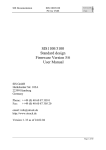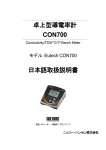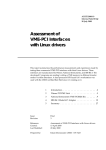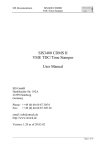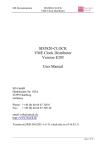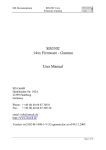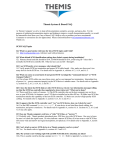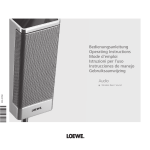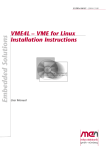Download SIS 3100 - Struck Innovative Systeme
Transcript
SIS Documentation SIS3100/3100 VME to VME SIS3100/3100 VME to VME interface 241002_V2 SIS3100 Initiator attendum to SIS1100/3100 User Manual SIS GmbH Harksheider Str. 102A 22399 Hamburg Germany Phone: ++49 (0) 40 60 87 305 0 Fax: ++49 (0) 40 60 87 305 20 email: [email protected] http://www.struck.de Version: Revision 1.01 as of 03.12.02 Page 1 of 31 SIS Documentation SIS3100/3100 VME to VME Revision Table: Revision 0.x 1.00 1.01 Page 2 of 31 Date 24.09.02 30.09.02 03.12.02 Modification Generation First official release VME base address change (because of limited addressing capabilities on some SBCs) SIS Documentation SIS3100/3100 VME to VME 1 Table of contents 1 2 3 4 5 Table of contents .............................................................................................................................................3 Introduction .....................................................................................................................................................3 Function/principle of operation .......................................................................................................................3 Address Map....................................................................................................................................................3 Register Description ........................................................................................................................................3 5.1 Type-Identifier/Version register(0x0, read).............................................................................................3 5.2 Firmware version register(0x4, read).......................................................................................................3 5.3 Interrupt configuration register (0x8) ......................................................................................................3 5.3.1 IRQ mode.........................................................................................................................................3 5.4 Interrupt control register (0xC)................................................................................................................3 5.5 Doorbell register (0x10, read only).........................................................................................................3 5.6 Optical status/control register (0x20, r/w) ...............................................................................................3 5.7 Protocol registers .....................................................................................................................................3 5.7.1 opt_prot_hdr register (0x80, r/w).....................................................................................................3 5.7.2 opt_prot_am register (0x84, r/w) .....................................................................................................3 5.7.3 opt_prot_adl register (0x88, r/w) .....................................................................................................3 5.7.4 opt_prot_dal register (0x90, r/w) .....................................................................................................3 5.7.5 opt_prot_error register (0xAC, read only) .......................................................................................3 5.8 Single Transfer Space Descriptor (0x400..0x4FC,read/write) ................................................................3 6 Protocol driven access .....................................................................................................................................3 6.1 Single Read..............................................................................................................................................3 6.2 Single Write .............................................................................................................................................3 6.3 DMA Read...............................................................................................................................................3 6.4 DMA Write..............................................................................................................................................3 7 Direct SGL access (mapping) ..........................................................................................................................3 8 LEDs................................................................................................................................................................3 8.1 Front panel LEDs.....................................................................................................................................3 8.1.1 Explanation of front panel LEDs .....................................................................................................3 8.1.2 Special case: LED Link up off.........................................................................................................3 8.2 PCB LEDs ...............................................................................................................................................3 9 VME system controller....................................................................................................................................3 10 Appendix .....................................................................................................................................................3 10.1 Power consumption..................................................................................................................................3 10.2 Jumper description...................................................................................................................................3 10.2.1 JP10 .................................................................................................................................................3 10.2.2 JP90 .................................................................................................................................................3 10.2.3 JP_DSP ............................................................................................................................................3 10.2.4 JP710 ...............................................................................................................................................3 10.2.5 JP770 ...............................................................................................................................................3 10.2.6 JP_DSP ............................................................................................................................................3 10.3 Boot mechanisms.....................................................................................................................................3 10.3.1 ISP PROM .......................................................................................................................................3 10.3.2 JTAG ...............................................................................................................................................3 10.4 Connector types .......................................................................................................................................3 11 Index ............................................................................................................................................................3 Page 3 of 31 SIS Documentation SIS3100/3100 VME to VME 2 Introduction The SIS3100/3100 VME to VME link is the third interface combination (after SIS1100/3100 PCI to VME interface and SIS1100/1100-OPT PCI to frontend readout system link) of the SIS Gigabit link series. The full scope of the interface family is sketched below. SIS3100 SIS1100OPT VME PCI Bus Page 4 of 31 SIS1100 SIS1100 VME SIS1100 SIS1100 SIS3100 CPU SIS3100 CAMAC SIS5100 SIS5100 VME SIS3100 CAMAC SIS3100 Detector mounted readout system SIS Documentation SIS3100/3100 VME to VME VME VME SIS3100 VME SIS1100 CPU SIS3100 VME SBC SIS3100 SIS3100 SIS3100 SIS3100 VME SIS3100 SIS3100 SIS3100 The initial implementation of the VME to VME link was made with the requirements of the DESY HERMES and the AMANDA detectors in mind. As many properties are given by the protocol implementation, which was made for the SIS1100/3100, this document was written as an SIS3100/3100 attendum which has to be seen in the context with the manual for the PCI to VME interface. PCI Bus Applications • Multi VME crate setups with single PCI slot • Multi VME crate setups with SBC (single board computer) as eventbuilder • Autonomous DSP based frontend crate readout with VME event collection • Long distance VME-VME connections Components The SIS3100/3100 VME to VME link consists of two SIS3100 cards and an interconnecting duplex fiber. The target SIS3100 module is equiped with all available options to allow for its use as subeventbuilder. • Initiator SIS3100 • Connecting optical fibre (up to 450 m) • Target SIS3100 with • SIS9200 SHARC DSP • 64 MB SDRAM option • Frontpanel I/O option Page 5 of 31 SIS Documentation SIS3100/3100 VME to VME 3 Function/principle of operation The SIS3100/3100 VME-VME link consists of two SIS3100 VME cards and an interconnecting optical fiber. The first SIS3100 is the so called initiator, the second SIS3100 is referred to as target. The target SIS3100 is installed in the remote crate, while the initiator is installed in the local crate. The SIS3100 initiator is a VME slave design. It has the task to simulate the function of the SIS1100 PCI card from the SIS1100/3100 PCI to VME interface. The target SIS3100 has the same firmware design as a card that is part of a PCI to VME interface. There are two ways for remote crate VME access • Protocol driven access • Mapped (single transfer) access While 3 (read) to 4 (write) VME cycles are required to initiate a transfer on the SIS3100 initiator with protocol driven access, mapped access allows access to the remote side in a single VME cycle. Especially on large word count block transfers the protocol overhead of the SIS3100/3100 VME to VME interface becomes negligible and the implemented block transfer modes up to 2e VME result in a high performance intercrate coupling. With the SIS9200 DSP, SDRAM and I/O option efficient autonomous event readout in the can be implemented in the target crate with no need for local VME master interaction. Page 6 of 31 SIS Documentation SIS3100/3100 VME to VME 4 Address Map The SIS3100 initiator is a A32 D32/BLT32/MBLT64/2eVME slave. The base address is defined with 5 jumpers of jumper array J10 as listed in the table below. Refer to section 10.2.1 for a detailed jumper description with a sketch of the array. A28 J10/8 A27 A26 A25 A24 J10/7 J10/6 J10/5 J10/4 A23-A0 occupied address pace The SIS3100 resources and their locations are listed in the table below. Offset 0x0000 0x0000 0x0000 0x0000 0x0000 Key Access Function 0000 0004 0008 000C 0010 R R R/W R/W R Type-Identifier/Version register Firmware Version register Interrupt configuration register Interrupt control register Doorbell register 0x0000 0020 0x0000 0024 R/W W Optical Status/Control register KEY: Requester-Confirmation Logic Reset 0080 0084 0088 0090 R/W R/W R/W R/W opt_prot_hdr opt_prot_am opt_prot_adl opt_prot_dal (dma_byte_length) 0x0000 00A8 0x0000 00AC R/W R opt_prot_balance counter opt_prot_error 0x0000 00B0 R 0x0000 0400 R/W SGL Transfer Space descriptor[0] 0x0000 04FC R/W SGL Transfer Space descriptor[63] 0x004x xxxx 0x007x xxxx R/W opt_prot_dma_fifo 0x0080 xxxx 0x0082 xxxx R/W R/W Direct SGL Transfer (descriptor[0]) Direct SGL Transfer (descriptor[1]) 0x00FE xxxx R/W Direct SGL Transfer (descriptor[63]) 0x0000 0x0000 0x0000 0x0000 KA opt_prot_dma_rd_byte_counter Note: Write access to a key address (KA)with arbitrary data invokes the respective action Page 7 of 31 SIS Documentation SIS3100/3100 VME to VME 5 Register Description 5.1 Type-Identifier/Version register(0x0, read) This read only register holds the board type to allow for a distinction between different interface types. The board type of the SIS3100 VME side is 1. Other stored parameters are hardware version, firmware type and firmware version. BIT access Name 7-0 RO Identifier Bedeutung 1 = PCI/PLX Interface 000000FF 2 = VME Controller 3 = CAMAC/FERA Controller 4 = Readoutsystem mit LVD SCSI 0x82 = VME initiator 15-8 RO Hardware Version 1..255 Firmware Type 1 = universal Firmware Version 1..255 0000FF00 23-16 RO 00FF0000 31-24 RO FF000000 The type identifier/version register for the SIS3100 initiator reads: 0x 01 01 01 82 5.2 Firmware version register(0x4, read) BIT access Name 7-0 RO Bedeutung Firmware Version 000000FF 15-8 RO Firmware type 0x82 (VME initiator) Board type 0x3100 0000FF00 31-16 RO FFFF0000 The firmware version register for the SIS3100 initiator (firmware version 2) reads: 0x 31 00 82 02 Page 8 of 31 SIS Documentation SIS3100/3100 VME to VME 5.3 Interrupt configuration register (0x8) This read/write register controls the VME interrupt behaviour of the SIS3100 initiator. The interrupter type is DO8 . 5.3.1 IRQ mode In RORA (release on register access) mode the interrupt will be pending until the IRQ source is cleared by specific access to the corresponding clear Doorbell IRQ bit. In ROAK (release on acknowledge) mode , the interrupt condition will be cleared as soon as the interrupt is acknowledged by the VME Master. Bit 31 .. 16 15 14 13 12 11 10 9 8 7 6 5 4 3 2 1 0 Function reserved .. reserved reserved reserved reserved RORA/ROAK Mode (0: RORA; 1: ROAK) VME IRQ Enable (0=IRQ disabled, 1=IRQ enabled) VME IRQ Level Bit 2 VME IRQ Level Bit 1 VME IRQ Level Bit 0 IRQ Vector Bit 7; placed on D7 during VME IRQ ACK cycle IRQ Vector Bit 6; placed on D6 during VME IRQ ACK cycle IRQ Vector Bit 5; placed on D5 during VME IRQ ACK cycle IRQ Vector Bit 4; placed on D4 during VME IRQ ACK cycle IRQ Vector Bit 3; placed on D3 during VME IRQ ACK cycle IRQ Vector Bit 2; placed on D2 during VME IRQ ACK cycle IRQ Vector Bit 1; placed on D1 during VME IRQ ACK cycle IRQ Vector Bit 0; placed on D0 during VME IRQ ACK cycle Default 0 0 0 0 0 0 0 0 0 0 0 0 0 0 0 0 0 0 0 The power up default value reads 0x 00000000 Page 9 of 31 SIS Documentation SIS3100/3100 VME to VME 5.4 Interrupt control register (0xC) This register controls the VME interrupt behaviour of the SIS3100 initiator. Bit 31 30 29 28 27 26 25 24 23 22 21 20 19 18 17 16 15 .. 0 Function (w) unused unused unused unused unused unused unused unused unused unused unused Clear Doorbell IRQ flag unused unused unused Disable Doorbell IRQ unused unused Enable Doorbell IRQ (r) 0 0 0 0 Status VME IRQ Status internal IRQ 0 0 0 0 0 Status Doorbell IRQ flag 0 0 0 0 0 0 Status Enable Doorbell IRQ (read as 1 if enabled, 0 if disabled) The power up default value reads 0x 00000000 Illustration of Status flag/IRQ flag and IRQ generation: VME_IRQ_ENABLE AND Status Doorbell IRQ flag doorbell IRQ pulse AND Clear Enable Doorbell IRQ Page 10 of 31 INTERNAL_VME_IRQ VME IRQ Default 0 0 0 0 0 0 0 0 0 0 0 0 0 0 0 0 0 0 0 SIS Documentation SIS3100/3100 VME to VME 5.5 Doorbell register (0x10, read only) Contains the Doorbell IRQ value of the Doorbell Request of the target. by the other pending IRQ with consecutive doorbell register update. Doorbell register bit 31:16 15 14 13 12 11 10 9 8 7 6 5 4 3 2 1 0 Function 0 (reserved) Status DSP_IRQ Status LEMO_ IN3_IRQ latch bit Status LEMO_ IN2_IRQ latch bit Status LEMO_ IN1_IRQ latch bit Status FLAT_ IN4_IRQ latch bit Status FLAT_ IN3_IRQ latch bit Status FLAT_ IN2_IRQ latch bit Status FLAT_ IN1_IRQ latch bit Status VME IRQ 7 bit Status VME IRQ 6 bit Status VME IRQ 5 bit Status VME IRQ 4 bit Status VME IRQ 3 bit Status VME IRQ 2 bit Status VME IRQ 1 bit 0 (reserved) Page 11 of 31 SIS Documentation 5.6 SIS3100/3100 VME to VME Optical status/control register (0x20, r/w) BIT Name 0 local acc Beschreibung RX_SYNCH RO Optical receiver synchronized TX_SYNCH RO Remote optical receiver synchronized SYNCH_CHG WR: sel clr RX/TX_SYNCH changed LOCAL_OPT_RESET WR: sel clr REMOTE_OPT_RESET WR: sel clr 00000001 1 00000002 4 00000010 8 00000100 12 00001000 RX_SYNCH valid characters are seen by the optical receiver from remote station, i.e. the connection between remote sender and local receiver is stable. TX_SYNCH is set when both directions of the optical connection are stable. This implies, that , RX_SYNCH is set also. LOCAL_OPT_RESET a reset is generated by writting a 1 to this bit. A reset sets all control register bits to 0, clears the input and output FIFO as well as the data link layer. REMOTE_OPT_RESET a SP_RESET special character is send to the remote (target) side if this bit is written to with a 1. The remote side has to react by initializing ist logic to a defined state. Page 12 of 31 SIS Documentation 5.7 SIS3100/3100 VME to VME Protocol registers Please refer to the SIS1100/3100 manual and the implemented Gigalink protocol for a detailed discussion of the protocol. SIS3100 initiator protocols are generated by writing to the local register set, which consist of the registers opt_ prot_hdr to opt_ prot _dal (i.e offset address 0x80 to 0x90). The error register opt_prot_error has to be checked after the completion of the transfer 5.7.1 opt_prot_hdr register (0x80, r/w) The value that is written to the bits 27 to 24 defines at what point the protocol will be transmitted. Bits 31 to 28 have special functions. The value of the lower bits 23 to 0 is written to the optical port as protocol header. Bits 29 0 no function 1 opt_prot_error register will be cleared with protocol start Bits 28 0 no function 1 DMA input FIFO will be reset upon protocol start Bits 27 to 24 0x0 no protocol will be send 0x1 protocol will be send upon write of opt_ prot_hdr. 0x2 protocol will be send upon write of opt_ prot_adl. 0x4 protocol will be send upon write of opt_ prot_dal. Note: you can minimize the number of required VME cycles by selecting the appropriate condition for protocol transmission. If you have a number of writes with the same data to different VME addresses (with same AM) it will make sense to use opt_prot_adl. If you have a number of writes to the same address but with varying data opt_prot_dal is the right choice. Page 13 of 31 SIS Documentation SIS3100/3100 VME to VME 5.7.2 opt_prot_am register (0x84, r/w) Protocol VME Address Modifier register 5.7.3 opt_prot_adl register (0x88, r/w) Protocol Address register 5.7.4 opt_prot_dal register (0x90, r/w) Protocol Data or DMA length register in Bytes. 5.7.5 opt_prot_error register (0xAC, read only) Name Code BUSY 0x005 LINK_ERROR 0x101 REQUEST_BUSY_TIMEOUT 0x103 CONFIRMATION_TIMEOUT 0x107 NOT_DEFINED_REQUEST 0x203 VME_BUSERR 0x211 VME bus error VME_RETRY 0x212 VME retry line set VME_ARBITRATION_TIMEOUT 0x214 Page 14 of 31 Description Optical link down, check fiber connection Timeout during VME arbitration (in multi master VME system) SIS Documentation SIS3100/3100 VME to VME 5.8 Single Transfer Space Descriptor (0x400..0x4FC,read/write) The 64 single transfer descriptors define the behaviour of the link during mapped access. Bit 31 .. 20 19 18 17 16 15 14 13 12 11...8 7 6 5 4 3 2 1 0 Function Optical Address bit A31 .. Optical Address bit A20 Optical Address bit A19 Optical Address bit A18 Optical Address bit A17 0 0 VME IACK 0 Optical SPACE 0 : remote SIS3100 internal space 1 : remote SIS3100 VME space 6 : remote SIS3100 SDRAM/SHARC space 0 0 VME AM5 VME AM4 VME AM3 VME AM2 VME AM1 VME AM0 The SIS3100 initiator is always accessed in A32. The remote crate address modifier (AM) is defined by the descriptors VME AM bits. Single cycle AM codes are valid only. The remote data width is defined by the width of the local access (Byte/Word/Lword). The VME IACK bit has to be set for an interrupt acknowledge cacle. Page 15 of 31 SIS Documentation SIS3100/3100 VME to VME 6 Protocol driven access 6.1 Single Read Execution of a single read is implemented as a sequence of: 1. write to one or more registers of the hdr, am, adl register set 2. wait for opt_prot_error not equal 0x5 (busy) data are valid if opt_prot_error == 0x0 and can be read from the tdal register a non zero opt_prot_error content signals an error condition (see 5.7.5) int vme_remote_A32D32_read(int p, u_int32_t local_base_adr, u_int32_t remote_vme_adr, u_int32_t* vme_data ) { int return_code ; int error ; vme_A32D32_write(p, local_base_adr + SIS3100_T_HDR, 0x3208010f ); vme_A32D32_write(p, local_base_adr + SIS3100_T_AM, 0x9) ; vme_A32D32_write(p, local_base_adr + SIS3100_T_ADL, remote_vme_adr) ; do { vme_A32D32_read(p, local_base_adr + SIS3100_T_PROT_ERROR, &error) ; } while (error == 0x005) ; if (error == 0x0) { vme_A32D32_read(p, local_base_adr + SIS3100_T_DAL, vme_data) ; return 0x0 ; /* OK exit */ } else { return error ; /* exit */ } } int sis3100_remote_control_read(int p, u_int32_t local_base_adr, u_int32_t remote_adr, u_int32_t* data ) { int return_code ; int error ; vme_A32D32_write(p, local_base_adr + SIS3100_T_HDR, 0x3200000f ); vme_A32D32_write(p, local_base_adr + SIS3100_T_ADL, remote_adr) ; do { vme_A32D32_read(p, local_base_adr + SIS3100_T_PROT_ERROR, &error) ; } while (error == 0x005) ; if (error == 0x0) { vme_A32D32_read(p, local_base_adr + SIS3100_T_DAL, data) ; return 0x0 ; /* OK exit */ } else { return error ; /* exit */ } } Page 16 of 31 SIS Documentation SIS3100/3100 VME to VME 6.2 Single Write Execution of a single write is implemented as a sequence of: 1. write to one or more registers of the hdr, am, adl, dal registers 2. wait for opt_prot_error ungleich 0x5 (busy) the write operation has completed successful if opt_prot_error == 0x0 a non zero opt_prot_error content signals an error condition (see 5.7.5) int vme_remote_A32D32_write(int p, u_int32_t local_base_adr, u_int32_t remote_vme_adr, u_int32_t vme_data ) { int return_code ; int error ; vme_A32D32_write(p, vme_A32D32_write(p, vme_A32D32_write(p, vme_A32D32_write(p, local_base_adr local_base_adr local_base_adr local_base_adr + + + + SIS3100_T_HDR, 0x340C010f ); SIS3100_T_AM, 0x9) ; SIS3100_T_ADL, remote_vme_adr) ; SIS3100_T_DAL, vme_data ) ; do { vme_A32D32_read(p, local_base_adr + SIS3100_T_PROT_ERROR, &error) ; } while (error == 0x005) ; if (error == 0x0) { return 0x0 ; /* OK exit */ } else { return error ; /* exit */ } } Page 17 of 31 SIS Documentation SIS3100/3100 VME to VME 6.3 DMA Read A DMA read cycle is a read request of N words, the sequence is: 1. write to one or more registers of the hdr, am, adl, dal register set 2. read N words from the DMA FIFO 3. after N words have been read (a local crate bus error occurred respective) the opt_prot_error register has to be checked for return code (0x0 flags proper termination) int vme_remote_A32BLT32_read(int p, u_int32_t local_base_adr, u_int32_t remote_vme_adr, u_int32_t* vme_data, u_int32_t req_num_of_lwords, u_int32_t* got_num_of_lwords) { int return_code ; int error ; /* header = 0x3428010f vme_A32D32_write(p, vme_A32D32_write(p, vme_A32D32_write(p, vme_A32D32_write(p, clr ERR, reset fifo, start with T_DAL ; local_base_adr local_base_adr local_base_adr local_base_adr + + + + BT, AM, VME, */ SIS3100_T_HDR, 0x3428010f ); SIS3100_T_AM, 0xb) ; /* remote AM */ SIS3100_T_ADL, remote_vme_adr) ; SIS3100_T_DAL, (req_num_of_lwords<<2)) ; vme_A32BLT32_read(p, local_base_adr + SIS3100_DMA_FIFO, vme_data, req_num_of_lwords, got_num_of_lwords) ; vme_A32D32_read(p, local_base_adr + SIS3100_T_PROT_ERROR, &error) ; return error ; /* exit */ } Note: The user has to make sure, that data are read from the DMA FIFO after completion of the protocol start sequence without long gaps, as a protocol timeout of 10 ms is implemented. Page 18 of 31 SIS Documentation SIS3100/3100 VME to VME 6.4 DMA Write A DME write cycle is a write request of N words, with following sequence: 1. write to one or more registers of the hdr, am, adl, dal register set 2. write N words to the DMA FIFO 3. after N words have been written wait for opt_prot_error not equal 0x5 (busy) opt_prot_error == 0x0 flags proper termination non zero opt_prot_error contents signals an error case int vme_remote_A32BLT32_write(int p, u_int32_t local_base_adr, u_int32_t remote_vme_adr, u_int32_t* vme_data, u_int32_t req_num_of_lwords, u_int32_t* put_num_of_lwords) { int return_code ; int error ; /* header = 0x242C010f clr ERR, start with T_DAL ; BT, AM, WR; VME, */ /* the DMA Write Fifo will be cleared automatically after sending protocol and then it is possible to write */ /* to it until the end of length is reached */ vme_A32D32_write(p, vme_A32D32_write(p, vme_A32D32_write(p, vme_A32D32_write(p, local_base_adr local_base_adr local_base_adr local_base_adr + + + + SIS3100_T_HDR, 0x242C010f ); SIS3100_T_AM, 0xb) ; /* remote AM */ SIS3100_T_ADL, remote_vme_adr) ; SIS3100_T_DAL, (req_num_of_lwords<<2)) ; vme_A32BLT32_write(p, local_base_adr + SIS3100_DMA_FIFO, vme_data, req_num_of_lwords, put_num_of_lwords) ; do { vme_A32D32_read(p, local_base_adr + SIS3100_T_PROT_ERROR, &error) ; } while (error == 0x005) ; if ((error == 0x0) && (return_code == 0x0 )) { return 0x0 ; /* OK exit */ } else { vme_A32D32_write(p, local_base_adr + SIS3100_REQ_CONF_RESET, 0x0) ; return ((return_code & 0xffff) + ((error & 0xffff) << 0x10) ) ; /* exit */ } } Note: The user has to make sure, that data are written to the DMA FIFO after completion of the protocol start sequence without long gaps, as a protocol timeout of 10 ms is implemented. Page 19 of 31 SIS Documentation SIS3100/3100 VME to VME 7 Direct SGL access (mapping) 64 mal 1 MByte windows are implemented to map single cycles in the local crate into the VME address space of the remote crate. 1. Example: read/write access to control register of remote crate (target) SIS3100 prepare mapping with write 0x0 to the address 0x400 (SGL Transfer Space descriptor(0)) direct access with read/write from/to address 0x04000000 ; 2. Example: VME read/write from/to remote crate (at offset address 0x87600000) prepare mapping with write 0x87610009 to the address 0x404 (SGL Transfer Space descriptor(1), VME, AM=9) direct VME access with read/write from/to address 0x04100000 ; Note: Remote crate error codes are passed to the local crate in a transparent fashion, i.e. a bus error (error code 0x211) during the remote crate VME access results in a bus error during the access to the mapped address. Page 20 of 31 SIS Documentation SIS3100/3100 VME to VME 8 LEDs The SIS3100 has 10 front panel and 8 surface mounted printed circuit board (PCB) LEDs to visualise part of the units status. While the front panel LEDs allow the user to monitor part of the boards activities, the PCB LEDs were implemented for hardware and firmware debugging purposes mainly. 8.1 Front panel LEDs The SIS3100 has 10 front panel and 8 surface mounted printed circuit board (PCB) LEDs to visualise part of LED A M P S R L LU LD U DU Color yellow red green green green Function Access (to VME slave port) not used Power Requester-Confirmation logic busy Ready (logic configured) Link up Link data up (initiator to target) Link data down (target to initiator) not used not used The arrangement of the front panel LEDs on the upper part of the front panel is shown in the sketch below. Page 21 of 31 SIS Documentation SIS3100/3100 VME to VME 8.1.1 Explanation of front panel LEDs LED A M P S R L LU LD U DU Description VME access to VME slave port of SIS3100 VME master, lit whenever the SIS3100 accesses the VME bus (not used with SIS3100 initiator design) Power, signals presence of +5 V supply voltage Signals activity of the SIS3100 sequencer Ready, lit when on board logic is configured (off during power up LED self test) Link up, lit when connection to PCI side (or loopback connection) is established Link data up, lit when data are send (and LED link up lit), special case as described below when LED link up is off Link data down, lit when link data are received (and LED link up lit), special case as described below when LED link up is off User LED, to be set and cleared under user program control (not used with SIS3100 initiator design) DSP user LED, to be set and cleared under optional DSPs user program (not used with SIS3100 initiator design) 8.1.2 Special case: LED Link up off In standard operation (i.e. both VME sides powered an connected with optical fiber) the LED Link up off condition signals a problem on the Gigabit link connection. The LEDs Link data up and Link data down are used to signal the problem cause under this condition. Link data up is lit in case of a problem on the transmitter side, link data down is lit in case of a problem on the receiver side. A short loopback cable (with proven reliability) is useful to track down the problem source (fiber, VME side or PCI side) 8.2 PCB LEDs The 8 red PCB LEDs D651-D658 are mounted close to the front panel on the upper edge of the SIS3100. The reflect the status of the Vitesse serialiser/deserialiser (SERDES) chip. LED D651 D652 D653 D654 D655 D656 D657 D658 Page 22 of 31 Function valid data valid KChar idle detect resync lossync norun error band error dispar error SIS Documentation SIS3100/3100 VME to VME 9 VME system controller The SIS3100 can act as VME system controller. The 16 MHz VME system clock is generated by the SMD oscillator U10. and enabled by jumper 1 of jumper array J10. This jumper has to be removed on the SIS3100 initiator as the module acts as a VME slave only. Note: The user has to ensure, that the system clock is generated once per crate only. A VME diagnosis module like the VDIS or a measurement with a VME bus extender can be used can be used to check, whether a particular CPU or interface generates system clock (with all other interfaces/CPUs unplugged from the VME backplane. Some VME slave modules may use the system clock to initialize on board resources, this mechanism may fail if the system clock is generated by more than one board in the crate. Page 23 of 31 SIS Documentation SIS3100/3100 VME to VME 10 Appendix 10.1 Power consumption The SIS3100 is a +5 V single supply design. On board voltages other than +5V are generated by linear regulators or DC/DC converters. A list with the used components can be found below. Component designator U2 U3 U5 U6 Voltage 2.5 V 3.3 V -5 V -5 V Component LT1584CT LT1584CT TMH0505S TMH0505S Powered components FPGAs link medium/SERDES/drivers flat cable in/outputs (ECL) LEMO in/outputs (NIM) Note: U5 and U6 will be stuffed when required by the given I/O configuration only The power consumption depends on installed options and board activity. The figures below are worst case estimates/measurements. U in V +5 V +5 V +5 V +5 V Page 24 of 31 Current in A 2,0 2,1 2,2 2,4 Configuration Base configuration (SIS3100 initiator) Base configuration with front panel I/Os Base configuration with front panel I/Os and 64 MB Base configuration with front panel I/Os, 64 MB and DSP SIS Documentation SIS3100/3100 VME to VME 10.2 Jumper description A description of the jumpers can be found in the following subsections. Please note, that some of the jumpers may not be used with the actual hardware configuration of your board. 10.2.1 JP10 Boot configuration/VME base address selection Function J10 Factory default setting open VME system controller (leave open on SIS3100 initiator) unused open GAP (not on SIS3100 initiator) open GA0 (VME slave address bit 24) open GA1 (VME slave address bit 25) open GA2 (VME slave address bit 26) open GA3 (VME slave address bit 27) open GA4 (VME slave address bit 28) closed With the factory default setting (GA4 closed, GA3 to GA0 open) the SIS3100 is configured for a VME base address of 0x10000000 Page 25 of 31 SIS Documentation SIS3100/3100 VME to VME 10.2.2 JP90 Function J90 unused Factory default setting open connect FPGA reset to LEMO reset output (na on SIS3100 initiator) connect power on reset to LEMO reset output (na on SIS3100 initiator) connect NIM reset input to execution of SIS3100 power on reset (see Note 3) (na on SIS3100 initiator) power on reset open VME SYSRESET initiates power on reset of SIS3100 FPGA reset results in VME SYSRESET open power on reset of SIS3100 results in VME SYSRESET open closed open closed closed Notes: 1.) some jumper combinations may result in a power up reset deadlock 2.) Typical Master/slave SYSRESET setting While it is typical for a VME master to issue SYSRESET upon power up (jumper 8 of J90 closed) it is more suited for a VME slave to execute a power on reset as soon as the VME SYSRESET condition is detected (jumper 6 of J90 closed). 3.) The width of the reset signal has to be greater than 20 ms Page 26 of 31 SIS Documentation SIS3100/3100 VME to VME 10.2.3 JP_DSP If the jumper JP_DSP is opened, the JTAG lines TDI and TDO of the installed SIS9200 DSP piggy will be connected to the main board and the programmable components on the card will become part of the SIS3100 JTAG chain. The default setting is jumper closed (i.e. closed TDI, TDO chain on the SIS3100 board). 10.2.4 JP710 Termination of flat cable inputs (not applicable for SIS3100 initiator). 10.2.5 JP770 Termination of LEMO inputs (not applicable for SIS3100 initiator). 10.2.6 JP_DSP If the jumper JP_DSP is opened, the JTAG lines TDI and TDO of the installed SIS9200 DSP piggy will be connected to the main board and the programmable components on the card will become part of the SIS3100 JTAG chain. The default setting is jumper closed (i.e. closed TDI, TDO chain on the SIS3100 board). Page 27 of 31 SIS Documentation SIS3100/3100 VME to VME 10.3 Boot mechanisms The firmware of the SIS3100 can be loaded to the boards FPGAs by two different mechanisms. Normally the user will use the factory installed firmware, which will be loaded at power up by default, in some cases it may be of interest however to load special designs or to upgrade the firmware to use extended functionality with the card. The boot options are listed in the table below. Mechanism ISP PROM JTAG Connector/Chip designator U501 CON500 Hardware XC18V04VQ44 9-pin header 10.3.1 ISP PROM A XILINX XC18V04 ISP (in system programmable) PROM is installed as default firmware load source of the SIS3100. The contents of the serial PROM can be altered via the JTAG port. The firmware upgrade procedure is online in the firmware section of our web site, so are the actual firmware files. 10.3.2 JTAG The XILINX_JTAG connector (CON500 ) is designed for the use with standard JTAG (Joint Test Action Group)programming tools like the XILINX.HW-JTAG PC can be either used to program the on board EEPROM, or to load firmware to the FPGAs directly for test purposes. Find the pin assignment of the JTAG connector below. Pin designator JCC GND nc TCK nc TDO TDI nc TMS Page 28 of 31 Description Supply voltage Ground not connected Test clock not connected Test data out Test data in not connected Test mode select SIS Documentation SIS3100/3100 VME to VME 10.4 Connector types Find below a list of the used connector types of the SIS3100. Designation U200 CON700 LEMO1-8 STD-168DIMM CON_D1 CON_D2 P1/P2 Function Optical Link Flat cable user I/O LEMO user I/O DIMM socket SHARC socket long SHARC socket short VME connector Manufacturer IBM TYCO LEMO Berg Samtec Samtec Harting Part Number IBM42F10SNNAA20 or 30 2-828581-0 EPL.00.250.NTN 88638-60002 TFM-150-02-S-D-A TFM-145-02-S-D-A 02011602101.00 Page 29 of 31 SIS Documentation SIS3100/3100 VME to VME 11 Index +2.5 V 24 +3.3 V 24 +5 V 24 16 MHz 23 -5 V 24 A 21 Address Map 7 AM 15 AMP 29 base address 7 Berg 29 boot mechanisms 28 CON_D1 29 CON_D2 29 CON500 28 CON700 29 connector types 29 CPU 23 DC/DC 24 DIMM 29 DMA FIFO 18, 19 DMA read 18 DMA write 19 DO8 9 DSP 27 DU 21 ECL 24 FIFO 18, 19 input 12 output 12 firmware 28 FPGA 28 Harting 29 IACK 15 IBM 29 interrupter mode 9 interrupter type 9 IRQ end of event 10 IRQ generation 10 IRQ mode 9 ROAK 9 RORA 9 ISP 28 ISP PROM 28 J10 7 JCC 28 JTAG 27, 28 jumper description 25 JP_DSP 27 JP10 25 JP710 27 JP770 27 JP90 26 system controller 23 key address 7 Page 30 of 31 L 21 LD 21 LED 20, 21 access 21 DSP user 21 front panel 21, 22 link data down 21 link data up 21 link up 21, 22 master 21 PCB 22 power 21 ready 21 surface mounted 21 user 21 LEMO 29 linear regulator 24 Link data down 22 data up 22 LU 21 M 21 nc 28 NIM 24 opt_prot_adl 14 opt_prot_am 14 opt_prot_dal 14 opt_prot_error 14 oscillator 23 P 21 P1 29 P2 29 PCB 21 power consumption 24 PROM 28 protocol temporary 13 protocol driven access 16 R 21 register board type 8 description 8 doorbell 7 firmware version 8 hardware configuration 12 interrupt configuration 9, 10, 11, 13 VME adress map 15 ROAK 9 RORA 9 RX_SYNCH 12 S 21 Samtec 29 SERDES 22 SHARC 29 single read 16 single write 17 SIS9200 27 SIS Documentation SP_RESET 12 STD-168DIMM 29 SYSRESET 26 TCK 28 TDI 28 TDO 28 TMS 28 TX_SYNCH 12 TYCO 29 U 21 SIS3100/3100 VME to VME U10 23 U200 29 VDIS 23 Vitesse 22 VME 29 bus extender 23 system controller 23 XC18V04 28 XILINX 28 XILINX_JTAG 28 Page 31 of 31































